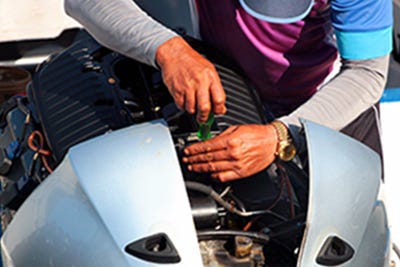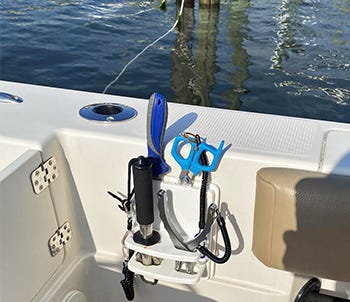

An ounce of prevention is worth a pound of cure, they say, but what they don’t say is that that’s the exchange rate on dry land. On the water, it’s a seller’s market. You would not want to try to buy beer or bonefish flies on the water, and good luck if you need something like hydraulic fluid.
Contents
Preparing For Mishaps That Happen To Everyone
Most of what goes wrong on the water can be prevented by either attentive maintenance or attentive piloting. But things do go sideways now and then. Screws get loose.
The spectrum of potential issues that can occur on the water range from the easy to address to the impossible. If you blow your motor on the water, there's not a thing in the world you can do about it right then and there, so there's really no point trying to prepare for that occurrence other than having a radio and flares aboard. If you blow a fuse, on the other hand, it will take you a couple minutes to replace it and get back to having fun — assuming you have a replacement fuse.
Assembling Your Tool Kit
Every boat has space and weight limitations, and tools are heavy, but you should keep some sort of tool kit on your boat with a selection of basic tools. Instead of buying a packaged one-size-fits-all tool kit, which will likely include a little bit of what you need and a lot of what you don’t, take an hour to build your kit around your particular boat.
A tool kit should include:
- A couple sets of pliers — slip-joint pliers (maybe two pairs) and needle-nose pliers should cover your needs
- An adjustable wrench and/or a small selection of wrenches
- Screwdrivers, both Phillips and flathead
- Spare fuses for your outboard and electrical panel
- Wire cutters with strippers and crimpers built-in
- Butt splices
- Electrical tape
Motor not Motorin’
The most common major problem on the water is just about certainly a motor that won’t start. An outboard with the cowling off while someone fiddles with it is practically a boat ramp fixture.
On the water, dead starting batteries are often the culprit. The radio’s playing, the fishfinder is on — and then you try to fire up the engine and … click.


With smaller engines, this is an easy problem to solve by busting out the starting rope. Starter rope in the garage? Fashion one from a dock or anchor line.
- Note to self: add pull-start rope to tool kit.
Large, high-compression motors can be a major chore to pull start. If your motor is cold and you can’t get it started with the rope, pulling a spark plug or three can make the job easier and help you get it started. Once warmed up, you may be able to pull-start the motor with all the plugs re-installed.
- Note to self: add spark plug socket and wrench to tool kit.
Electron Flow Interrupted
The elements are hard on electrical systems. Contacts corrode, insulation wears at rub points, and fuses blow.
Most outboards are delivered with spare fuses in storage under the cowling, often with a fuse puller stored alongside. Of course, any fuse that blows once can blow a second time, so it’s a good idea to have multiple replacement fuses of each type and amperage rating on your boat in case you need to troubleshoot a recurring electrical problem.
Battery terminal connections can and do go bad.
- Note to self: add a wire brush for cleaning battery terminals to tool kit.
If there are electronics aboard that you absolutely depend on, like sonar and GPS units, dielectric grease or contact cleaner are helpful in keeping them running.
A couple of feet of spare 14 or 16 ga. wire may also save your day.
Switches on boats are often exposed and vulnerable to water damage over time, though a bad jackplate or trim tab switch shouldn’t leave you stranded at sea. In the worst-case scenario, you can disconnect the wires from the switch and operate equipment by touching the appropriate wires momentarily by hand. If you find yourself replacing a bad switch, buy two and put the spare in the tool kit.
Other Things to Fail
Bilge pumps are critical equipment you might not think much of until you really need yours. A failed bilge pump is bad news and potentially a real emergency, but it’s also a very fixable problem on the water — if you have a spare motor cartridge aboard.
- Note to self: add spare bilge pump cartridge to tool kit.
Being unable to steer is almost as bad as being unable to move at all. If your boat has hydraulic steering, you should keep aboard the fill hose for your steering system and spare hydraulic fluid.
First Aid
The most common mishap on a boat is dropping something over the side. Sunglasses, pliers, Boga Grips — splash, gone. Put them on a retainer or attach them to a float: problem solved.
The second most common mishap might be getting stuck with a fishhook. If you’ve ever dealt with a handful of treble hooks or put a 3/0 tarpon fly in your ear, you are probably already in the barbless club. Bluefish and Northern pike like to draw blood.
At any rate, a good first aid kit should be on any boat.


Plan and Prep
Your owner’s manual won’t be much help if it’s in a bin on a shelf in the garage as you are having some problem on the water. Keep owner’s manuals aboard for important equipment. Most manuals will have a troubleshooting section.
But having info aboard is not as good as being prepared to deploy knowledge. We generally don’t get to pick the location and timing of our mishaps, and the urgency of diagnosing and solving a problem can be heightened by conditions. It’s one thing if the motor won’t start and it’s calm and pleasant, but another if the motor won’t start and a falling tide is rapidly draining a flat as an onshore wind pins you place.
Knowing what to do and then doing it efficiently can be the difference between a minor mishap and a serious problem.
You may get in a situation in which you need to act quickly — which is to say that finding yourself pinned on that flat should not be the first time you’ve ever tried to pull-start your electric-start outboard. Pick a nice day when you have plenty of time to play with pull-starting your motor. Get familiar with all the fuses on your boat, including any inline fuses that may be installed.
Knowing what to do and then doing it efficiently can be the difference between a minor mishap and a serious problem, or at least the difference between a fun day on the water and a day spent getting back to the dock.
